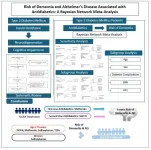Recent developments at MD Anderson offer insights into mechanisms regulating metabolic programming and cellular senescence, a new treatment option for patients with Ewing’s sarcoma, personalized treatment strategies to enhance the effectiveness of RAS inhibitors in lung cancer, breast-conserving therapy as a viable treatment option for BRCA-associated breast cancers, the reduction of severe immunotherapy side effects without compromising antitumor activity, and new disease classifications for myeloid neoplasms.
Study uncovers new roles for METTL3 in metabolic programming and senescence
A particular area of interest in uncovering the earliest mechanisms driving cancer is a stress response cell state called senescence, in which cells stop growing but continue to function. Senescence has a known role in preventing cancer, but its underlying mechanisms are largely unknown. In a study led by Rugang Zhang, Ph.D., researchers uncovered some of these mechanisms by investigating the role of METTL3, a methyltransferase enzyme that helps regulate gene expression. They found that METTL3 contributed to senescence in several ways, notably through mediating chromatin loops, which induce Hexokinase 2 expression to then promote a process known as stress granule phase separation. This process is a form of metabolic programming that halts the production of certain proteins that promote cell growth. This mechanism is an important finding, as this previously unknown role of METTL3 could provide insights into how it contributes to cancer growth. Learn more in Nature.
First-in-human trial yields positive results in prolonging life in young patients with Ewing’s sarcoma
Adolescents and young adults with Ewing’s sarcoma (ES), a highly aggressive bone cancer, have few treatment options and a poor prognosis for recurrence. A multi-center Phase I/II clinical trial co-led by Joseph Ludwig, M.D., investigated the ability of the novel small molecule TK216 to disrupt the oncogenic fusion protein EWS-FLI1 in previously treated, relapsed/recurrent ES. In the study, 85 ES patients between the ages of 11 and 77 received TK216 by a continuous intravenous infusion. Researchers observed two complete responses, one partial response and 14 patients with stable disease, demonstrating anti-tumor efficacy. One patient achieved a complete response following five relapses of ES, and the patient remains ES free for more than 55 months after study initiation. These findings suggest a potential path forward to investigate prospective drug candidates that target the pathognomonic fusion protein in ES and other sarcoma subtypes. Learn more in the Journal of Clinical Oncology.
Active RAS inhibition yields antitumor activity in models of difficult-to-treat KRAS mutant lung cancer
Resistance to certain KRAS G12C inhibitors can result from the buildup of active, GTP-bound RAS, which can increase tumor growth in cancer patients. Therefore, effectively blocking active RAS becomes crucial. In a recent study, researchers led by Ferdinandos Skoulidis, M.D., Ph.D., and Haniel Araujo, M.D., evaluated the antitumor effects of a new class of inhibitors that target the active form of RAS proteins: RMC-7977, a pan-RAS inhibitor of KRAS/HRAS/NRAS, and RMC-4998, a RAS G12C-selective inhibitor. Active RAS inhibition resulted in robust and sustained tumor shrinkage across multiple difficult-to-treat, treatment-resistant lung cancer models. Combining the two inhibitors induced cures in some models. In addition, the study revealed a mucinous program in tumor cells that supports RAS inhibitor tolerance and may predict poor response to FDA-approved KRAS G12C inhibitors sotorasib or adagrasib in patients with advanced KRAS G12C-mutant non-small cell lung cancer. These findings may aid in developing personalized strategies and improving RAS inhibitor treatments for patients with lung cancer. Learn more in Cancer Discovery.
New computational tool helps researchers better understand complex steps in cancer evolution
As cancers evolve, they accumulate genetic changes that can be used to track their progression and learn more about their biology. Copy number changes, in which segments of DNA are gained or lost, often are complex and occur in multiple steps, making them harder to reconstruct. In a new study, Peter Van Loo, Ph.D., and colleagues report the development of a new algorithm, called Gain Route Identification and Timing In Cancer (GRITIC), to better determine how copy number changes arise over time during cancer evolution. After benchmarking the tool, the researchers applied GRITIC to 6,091 primary and metastatic tumors from multiple cohorts. They learned that copy number evolution occurs through more complex routes than previously understood. Additionally, they discovered that cases of whole-genome doubling, in which cells duplicate their entire genomes, increase the rates of chromosomal instability. The researchers anticipate this tool could help to better understand cancer evolution to inform future early detection, prevention and treatment strategies. Learn more in Cancer Discovery.
Study shows long-term effectiveness of breast-conserving therapy in BRCA-associated breast cancer
For patients with BRCA-associated breast cancer, bilateral mastectomy often is chosen to reduce the risk of future breast cancers. However, some women opt for breast-conserving therapy (BCT), accepting the associated risks. Researchers led by Kerollos Wanis, M.D., Ph.D., and Henry Kuerer, M.D., Ph.D., reviewed outcomes from 172 women with BRCA variants who were treated with BCT from 1977 to 2021. They found that women with BRCA1 variants were younger and had more aggressive tumors compared to those with BRCA2 variants. Despite higher risks, 88.5% survived at least 10 years after treatment, with 12.2% experiencing recurrence in the same breast and 21.3% developing cancer in the opposite breast. Most women who survived beyond 10 years avoided another cancer diagnosis and bilateral mastectomy. These findings help women with BRCA-associated breast cancer make informed decisions about choosing breast-conserving therapy. Learn more in JAMA Network Open.
Immunosuppressive therapy after checkpoint inhibitors can reduce side effects without compromising antitumor activity
Immune checkpoint inhibitors, such as anti-CTLA-4 or anti-PD-1 therapies, have resulted in dramatic antitumor responses for many patients. However, they can cause a variety of immune-related side effects, including myocarditis, a potentially life-threatening inflammation of the heart. Previous work demonstrated CTLA-4 Ig – an inhibitor of T cell costimulation – can protect against myocarditis, but the impacts on antitumor activity were unclear. In a new study led by Stephen Mok, Ph.D., and James Allison, Ph.D., treatment with CTLA-4 Ig after checkpoint inhibitors improved antitumor responses in preclinical models, regardless of the checkpoint inhibitors used. In contrast, CTLA-4 Ig given at the same time as checkpoint inhibitors reduced their efficacy. CTLA-4 Ig reduced the frequency of immunosuppressive regulatory T cells, which likely explains the responses seen. These results suggest CTLA-4 Ig can reduce severe side effects without compromising antitumor activity. Learn more in Proceedings of the National Academy of Sciences.
NPM1-mutated myeloid neoplasms are independent of bone marrow blast percentage
NPM1-mutated myeloid tumors with less than 20% bone marrow blasts are uncommon, and their classification remains inconsistent. In a new study led by Guillermo Montalban Bravo, M.D., researchers evaluated the clinicopathologic features of 54 patients with NPM1-mutated myeloid neoplasms and less than 20% bone marrow blasts compared with patients who had greater than 20% bone marrow blasts. Both groups had similar features regardless of blast percentage, except patients with more than 20% blasts had higher IDH2 and FLT3 mutation frequencies. Higher complete remission rates and median overall survival were observed in patients who were treated with intensive chemotherapy. Increased survival was observed in patients who had a stem cell transplant and were treated with low-intensity chemotherapy. These findings offer insight into new disease classifications, based on specific genetic abnormalities, and the optimal treatment selection in this rare group of patients with NPM1 mutations and less than 20% blasts. Learn more in Cancer.
Awards and honors
Susan K. Lee, Ph.D., associate professor in the School of Health Professions, has been selected as an ambassador for the Friends of the National Institute of Nursing Research. In case you missed it
Read below to catch up on recent MD Anderson press releases.
Study supports precision radiation therapy in lung cancer MD Anderson and Rice launch Cancer Bioengineering Collaborative Activating molecular target reverses multiple hallmarks of aging CAR NK cells with CD28 costimulation improved cell persistence and antitumor activity Read this press release in the MD Anderson Newsroom.
- 30 -
END


